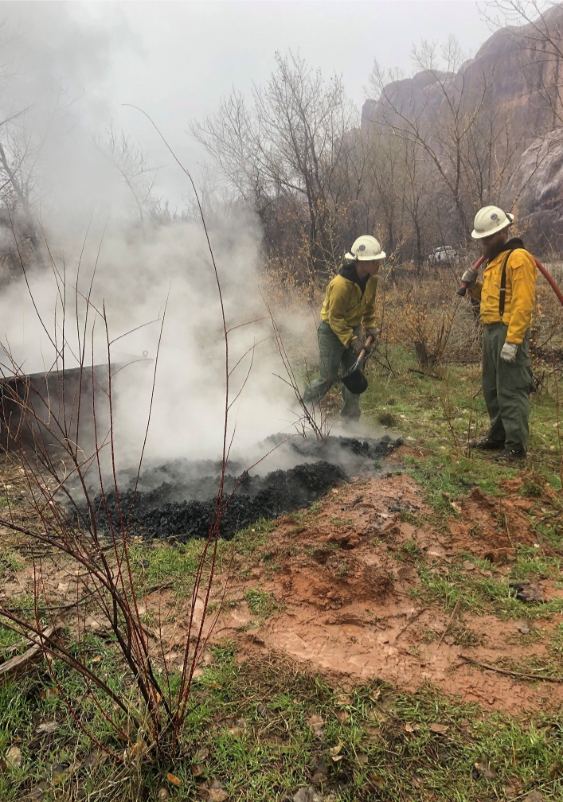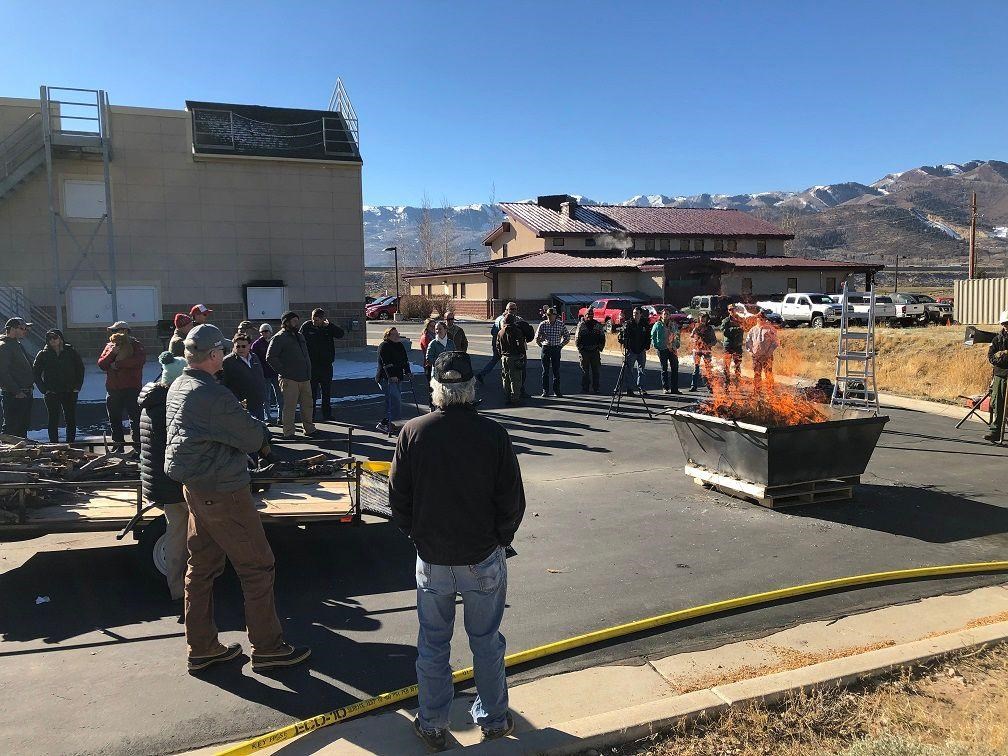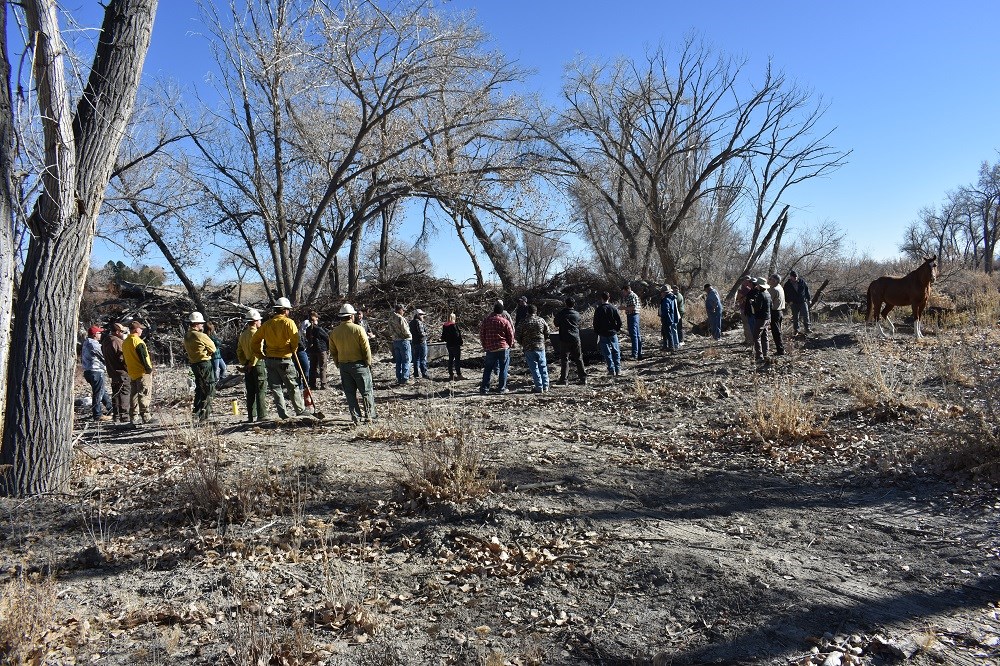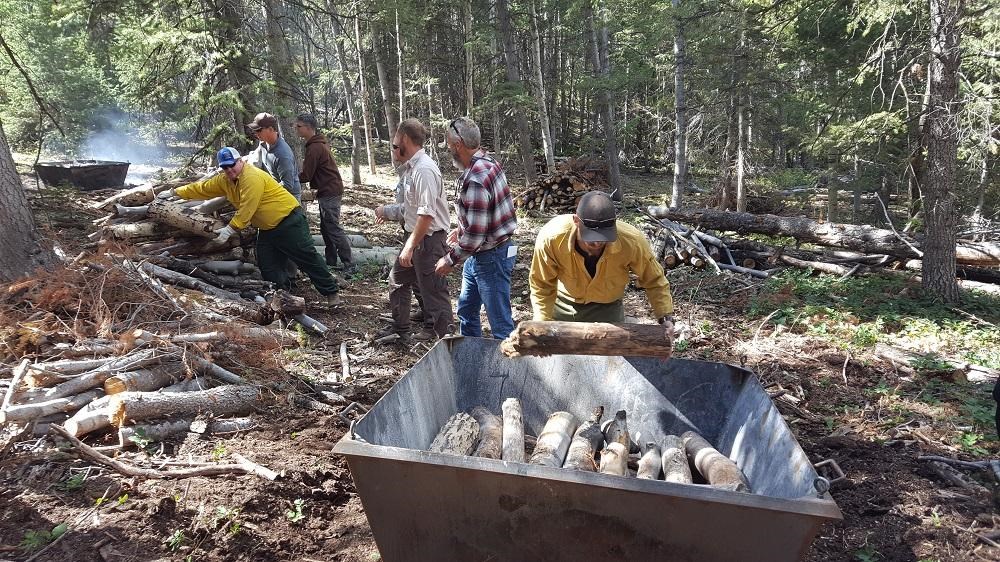039 - Taking it to the Road: Utah Biochar Workshops Increase Knowledge and Lead to Behavior Change
Why Workshop?

Quenched biochar that was dumped and spread during a biochar workshop in Moab, Utah.
Implementing and evaluating state-wide biochar workshops have become a crucial component of USU Forestry Extension's suite of outreach programs. These events foster dialogue between landowners, community members, and professionals who may not have met otherwise, and provide a space to generate ideas and foster discussions around natural resource stewardship that often precede action. Our biochar workshops provide an opportunity to enhance understanding about forestry, wildland fire, climate change, carbon sequestration, soil health, air quality, and invasive species management.
Workshops and demonstrations are effective at changing public attitudes and behaviors. Moroney and colleagues found the public preferred and strongly supported face-to-face workshops to receive information on woody biomass (Moroney, Laninga, & Brooks, 2016). Parkinson and colleagues found hands-on learning opportunities were effective in educating rural Idaho communities on fire preparedness, and post-workshop surveys indicated positive attitudes and beliefs about supporting fire management programs (Parkinson, Force, & Smith, 2002). These results demonstrate the positive impacts that result when scientists engage the public in hands-on learning environments such as workshops, and our experiences conducting biochar workshops support these findings. The informal atmosphere of our workshops was created on purpose; it has allowed us to effectively 1) present and exchange a significant amount of information about biochar techniques 2) create a space for dialogue with the public, and 3) foster a sense of mutual respect and trust between experts and the public. Engaging non-scientists through workshops, websites, or in print material is effective for communicating science to the public and is the foundation on which our biochar workshops are conducted (Brownell, Price, & Steinman, 2013).
Why Evaluate?

Group discussion during a biochar workshop in Emery County, Utah.
Two models are traditionally used as a guide for Extension professionals conducting evaluations: Bennett’s Hierarchy and the Logic Model (Bennet, 1975; Wholey, 1979). Table 1 demonstrates how our biochar workshops fit within Bennett’s hierarchy and the Logic Model.
Bennett noted that step 6 is essential for evaluating Extension programs, however, many Extension educators may not evaluate beyond step 5 (Bennett, 1975; Lamm, Israel, & Diehl, 2013; O’Neill, 1998; Workman & Scheer, 2012). Capturing this data means Extension has the opportunity to document the full picture of the public good stemming from their programs (Stup, 2003). We recognized the need to fill this gap and modified our evaluation strategy in 2017 to include immediate and long-term surveys that measure attitudinal and behavioral impacts and practices that were adopted due to attending the biochar workshops. This fact sheet documents the higher-level impacts (step 6 of Bennet’s hierarchy and Outcomes-Impact, long-term of Logic Model) stemming from our biochar workshops. Specifically, we report on knowledge gained, behavior changes, and the public benefits from attending our biochar workshops. View a complete description of our workshops.
| Program Logic Model Framework | Bennett’s Hierarchy Evaluation Model | Biochar Workshop Program |
|---|---|---|
| Inputs | Step 1: Inputs/Resources | Created the workshop program (advertising, content & feedstock preparation, safety precautions, burn permits) |
| Outputs | Step 2: Activities | Conducted the workshops (information exchange, interacting with public, connecting workshop attendees with external and internal resources) |
| Outputs | Step 3: Participation | Identified workshop reach (participants, public/private officials, landowners, decision makers) |
| Outcomes-Impact (Short-term outcome) | Step 4: Reactions | Observed initial reactions/experiences apparent at workshops |
| Outcomes-Impact (Medium-term outcome) | Step 5: KASA Change (knowledge, attitude, skills, aspirations) | Measured knowledge gained, attitude change, skills acquired, aspirations following workshop (using data from survey to understand pre/post workshop KASA change) |
| Outcomes-Impact (Long-term outcome) | Step 6: Practice Change | 6 to 8 months following workshop, measured practices adopted as a result of attending the workshop |
| Outcomes-Impact (Long-term outcome) | Step 7: End Results (public good) | Administered targeted survey to evaluate qualitative, snowball effects that may have stemmed from workshops |
Methods
Between 2017 and 2019 we held six biochar workshops with a total of 180 attendees. We situated the workshops throughout the state near accessible forests and rangelands that had excessive fuel buildup which required disposal. We solicited workshop participation through traditional (local news) and modern (social media) outlets. We created and administered two online Qualtrics surveys to evaluate the immediate impacts (sent 1-14 days post-workshop), and the higher-level impacts (sent 6 to 8 months post-workshop) to document behavior changes and practices adopted . Due to the timing of survey administration, this fact sheet presents results from 4 of the workshops which had a total of 122 attendees. Overall we received 54 responses for the higher-level impact survey which represents a 44% return rate. We also collected data from workshop attendees that were making biochar through the Summit County Extension kiln borrowing program. We distributed this opt-in Qualtrics survey throughout 2018 and received 9 responses from people who attended our workshop and consequently made biochar on their own.
Results

Group discussion during a biochar workshop in Park City, Utah.
Survey Results: 6 to 8 Months Post-workshop
We wanted to find out if knowledge and interest in biochar, along with the propensity to create biochar and/or a biochar kiln increased 6 to 8 months after attending one of the workshops. Our survey indicated four important impacts:
- 33% attempted to make biochar
- 51% have added biochar to the soil or land they managee
- 11% made a biochar kiln within 6 months of a workshop
- 73% were likely or extremely likely to attend another biochar workshop
Survey Results: Are People (Independently) Making Biochar?
We also wanted to know if people were making biochar on their own. Summit County Extension made 2 kilns available to anyone interested in making biochar and once we learned that someone had plans to make biochar or borrow a kiln, we administered a short follow-up survey. Our findings indicate that in the first year, 9 private landowners, non-profit employees, farmers, and private and public land managers made biochar from aspen (Populus spp.), pine (Pinus spp.), chokecherry (Prunus spp.), and scrub oak (Quercus spp.). We asked what motivated them to make biochar and found that 63% were generally curious about biochar and had a desire to experiment with the process, 13% had an interest in fuels reduction, and 25% had a desire to apply biochar to their land. Most respondents (75%) indicated they would consider borrowing a kiln in the future, 20% of respondents agreed that amending their soil and reducing fuels was easier because the kilns were available to borrow, and 40% agreed that having the opportunity to borrow the kilns and have the hands on experience making biochar was beneficial.
Conclusions
6 to 8 Months Post-workshop
Our results support previous findings that demonstrate positive impacts resulting from educational workshops. Specifically, we found increases in knowledge, desirable behavior changes, and propensity to attend future biochar workshops. Our 6 to 8 month survey showed that nearly one-third of attendees attempted to make biochar and 11% made a kiln based on what they learned at one of the workshops. This shows a direct change in behavior due to attending a workshop which may increase state-wide biochar use and lead to a reduction of hazardous fuels over time. Nearly two-thirds of workshop attendees were likely or extremely likely to attend an upcoming biochar workshop. These findings demonstrate the high value in our workshop and survey approach, which can be used as an indicator of future attendance and long-term success.
Are People Independently Making Biochar?

This picture is from a biochar workshop in Emery County, Utah and is emblematic of the diverse group of attendees that commonly attend these events. Pictured here are firefighters, members of the public, ranchers, and state and federal employees (and one horse). The group was learning how to make biochar from the invasive Russian-olive tree (Elaeagnus angustifolia).
We found that people are independently making biochar after attending one of the biochar workshops. These results demonstrate behavior change and tangible benefits that stem from biochar workshops and while our sample size is small, the experience gained and program reach is evident. Capturing these “snowball effect” impacts will remain a part of upcoming workshop evaluations.
These findings support the notion that Extension evaluations have more power when behavior change and long-term outcomes are evaluated (Bennett, 1975; Lamm, Israel, & Diehl, 2013; Workman & Scheer, 2012). For Extension programs to be the most effective they must change individual attitudes or behavior or benefit society (Lamm, Israel, & Diehl, 2013; Diem, 2003). Based on our results, we recommend conducting immediate follow up surveys (1 to 2 weeks) as well as long-term surveys (6 to 8 months) after a workshop. We plan to administer additional long-term surveys (1 to 2 years post-workshop) to further evaluate the temporal relationship between workshop attendance and behavior change(s). If this kind of information could be useful to educators, we recommend doing the same. This comprehensive assessment has allowed USU Extension Forestry to continue evaluating outcomes and impacts while simultaneously enhancing the Biochar Workshop Program.
 Attendees are working with firefighters to load the kiln for a biochar demonstration that took place during a workshop and forestry tour near Soldier Summit, Utah.
Attendees are working with firefighters to load the kiln for a biochar demonstration that took place during a workshop and forestry tour near Soldier Summit, Utah.


All of the images in this fact sheet are courtesy of Darren McAvoy or Megan Dettenmaier
Resources
- Bennett, C. (1975). Up the hierarchy. Journal of Extension, March/April.
- Brownell, S. E., Price, J. V., & Steinman, L. (2013). Science communication to the general public: Why we need to teach undergraduate and graduate students this skill as part of their formal scientific training. Journal of Undergraduate Neuroscience Education, 12(1), E6-E10.
- Diem, K. G. (2003). Program development in a political world—It's all about impact. Journal of Extension, 41(1), Article 1FEA6.
- Lamm, A. J., Israel, G. D., & Diehl, D. (2013). A national perspective on the current evaluation activities in Extension. Journal of Extension, 51(1), Article 1FEA1.
- Moroney, J., Laninga, T., & Brooks, R. (2016). Slash and learn: revealing stakeholder knowledge, support, and preferred communication methods relative to wood-based biofuels projects. Journal of Extension, 54(5), Article 5RIB10.
- O'Neill, B. (1998). Money talks: Documenting the economic impact of Extension personal finance programs. Journal of Extension, 36(5), Article 5FEA2.
- Parkinson, T. M., Force, J. E., & Smith, J. K. (2003). Hands-on learning: its effectiveness in teaching the public about wildland fire. Journal of Forestry, 101(7), 21-26.
- Stup, R. (2003). Program evaluation: Use it to demonstrate value to potential clients. Journal of Extension, 41(4), Article 4COM.
- Wholey, J. S. (1979). Evaluation: Promise and performance. Washington, DC: The Urban Institute.
- Workman, J. D., & Scheer, S. D. (2012). Evidence of impact: Examination of evaluation studies published in the Journal of Extension. Journal of Extension, 50(2). Article 2FEA1.
Published February 2020.

